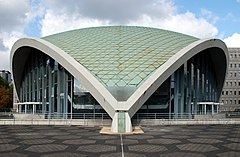Dortmund Opera
| Opernhaus Dortmund | |
|---|---|

The opera house in 2008
|
|
| General information | |
| Location | Dortmund, North Rhine-Westphalia, Germany |
| Coordinates | 51°30′40″N 7°27′42″E / 51.5110°N 7.4616°ECoordinates: 51°30′40″N 7°27′42″E / 51.5110°N 7.4616°E |
| Opened | 1966 |
| Design and construction | |
| Architect |
|
| Website | |
| www |
|
Opernhaus Dortmund is the opera house of Dortmund, Germany, which opened in 1966 and is formally operated by the Theater Dortmund organisation. This is the second opera house to exist in Dortmund, the first one having been built in 1904, but it was destroyed during World War I.
The 1966 opera house was designed by architects Heinrich Rosskotten and Edgar Tritthart. The design separates the functions of the stage and technical areas in the Bühnenhaus (stage house), which is dominated by straight lines, from the auditorium under a thin-shell structure roof.
The new house opened on 3 March 1966 to serve as a venue for operas, ballets, concerts, and for plays which require a big stage. The inaugural performance was Richard Strauss's Der Rosenkavalier, an opera which had been first performed in 1911, shortly after its premiere; Wilhelm Schüchter conducted the Dortmunder Philharmoniker.Teresa Żylis-Gara appeared as Octavian, along with guest artist Elisabeth Grümmer as the Marschallin and Kurt Böhme as Ochs. In the short remaining part of the season, Verdi's Il trovatore, with Fedora Barbieri as Azucena, Mozart's Die Zauberflöte, Hindemith's Mathis der Maler, and Johann Strauss' Der Zigeunerbaron were performed.
The first plays staged in the so-called Großes Haus during this period were Brecht's Leben des Galilei and Anouilh's Becket. Unusual for the era of the iron curtain, the Volkstheater performed Peter Weiss's Die Verfolgung und Ermordung Jean Paul Marats dargestellt durch die Schauspielgruppe des Hospizes zu Charenton unter Anleitung des Herrn de Sade.
...
Wikipedia
